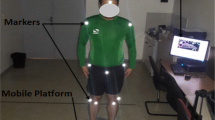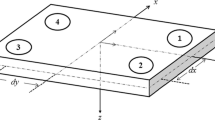Abstract
This study addresses the challenge of identifying the features of the Centre of pressure (COP) trajectory that are most sensitive to postural performance, with the aim of avoiding redundancy and allowing a straightforward interpretation of the results. Postural sway in 50 young, healthy subjects was measured by a force platform. Thirty-seven stabilometric parameters were computed from the one-dimensional and two-dimensional COP time series. After normalisation to the relevant biomechanical factors, by means of multiple regression models, a feature selection process was performed based on principal component analysis. Results suggest that COP two-dimensional time series can be primarily characterised by four parameters, describing the size of the COP path over the support surface; the principal sway direction; and the shape and bandwidth of the power spectral density plot. COP one-dimensional time series (antero-posterior (AP) and medio-lateral (ML)) can be characterised by six parameters describing COP dispersion along the AP direction; mean velocity along the ML and AP directions; the contrast between ML and AP regulatory activity; and two parameters describing the spectral characteristics of the COP along the AP direction. On the basis of the results obtained, some guidelines are suggested for the choice of stabilometric parameters to use, with the aim of promoting standardisation in quantitative posturography.
Similar content being viewed by others
References
Acciani, G., Chiarantoni, E., Fornarelli, G., andVergura, S. (2003): ‘A feature extraction unsupervised neural network for an environmental data set’,Neural Netw.,16, pp. 427–436
Baratto, L., Morasso, P., Re, C., andSpada, G. (2002): ‘A new look at posturographic analysis in the clinical context: sway-density vs. other parameterization techniques’,Motor Control,6, pp. 248–273
Castellano, G., andFanelli, A. M. (2000): ‘Variable selection using neural-network models’,Neurocomputing,31, pp. 1–13
Chiari, L., Bertani, A., andCappello, A. (2000a): ‘Classification of human strategies in human postural control by stochastic parameter’,Hum. Mov. Sci.,19, pp. 817–842
Chiari, L., Cappello, A., Lenzi, D., andDella, C. U. (2000b): ‘An improved technique for the extraction of stochastic parameters from stabilograms’,Gait Post.,12, pp. 225–234
Chiari, L., Rocchi, L., andCappello, A. (2002): ‘Stabilometric parameters are affected by anthropometry and foot placement’,Clin. Biomech. (Bristol, Avon),17, pp. 666–677
Cocchi, M., Hidalgo-Hidalgo-De-Cisneros, J. L., Naranjo-Rodríguez, I., Palacios-Santander, J. M., Seeber, R., andUlrici, A. (2003): ‘Multicomponent analysis of electrochemical signals in the wavelet domain’,Talanta,59, pp. 735–749
Collins, J. J. andDe Luca, C. J. (1993): ‘Open-loop and closed-loop control of posture: a random-walk analysis of center-of-pressure trajectories’,Exp. Brain Res.,95, pp. 308–318
Deluzio, K. J., Wyss, U. P., Zee, B., Costigan, P. A., andSorbie, C. S. (1997): ‘Principal component models of knee kinematics and kinetics: normal vs. pathological gait patterns’,Hum. Mov. Sci.,16, pp. 201–217
Diener, H. C., Dichgans, J., Bacher, M., andGompf, B. (1984): ‘Quantification of postural sway in normals and patients with cerebellar diseases’,Electroencephalogr: Clin. Neurophysiol.,57, pp. 134–142
Fodor, I. K. (2002): ‘A survey of dimension reduction techniques’. LLNL Technical Report, UCRL-ID-148494
Fukunaga, K., andKoontz, W. L. G. (1970): ‘Application of the Karhunen-Loeve expansion to feature selection and ordering’,IEEE Trans. Comput.,19, pp. 311–318
Hintze, J. L. (2000): ‘NCSS user's guide’ (NCSS, Kaysville, 2000)
Hufschmidt, A., Dichgans, J., Mauritz, K. H., andHufschmidt, M. (1980): ‘Some methods and parameters of body sway quantification and their neurological applications’,Arch. Psychiatr. Nervenkr.,228, pp. 135–150
Hyvarinen, A. (1999): ‘Survey on independent component analysis’,Neural Comput. Surv.,2, pp. 94–128
Jolliffe, I. T. (1972): ‘Discarding variables in a principal component analysis, I: Artificial data’,Appl. Statist.,21, pp. 160–173
Jolliffe, I. T. (1986): ‘Principal component analysis’ (Springer-Verlag, New York, 1986).
Kaiser, H. F. (1960): ‘The application of electronic computers to factor analysis’,Educ. Psychol. Meas.,20, pp. 141–151
Kapteyn, T. S., Bles, W., Njiokiktjien, C. J., Kodde, L., Massen, C. H., andMol, J. M. (1983): ‘Standardization in platform stabilometry being a part of posturography’,Agressologie,24, pp. 321–326
Karlsson, A., andFrykberg, G. (2000): ‘Correlations between force plate measures for assessment of balance’,Clin. Biomech., Bristol, Avon,15, pp. 365–369
Kaufman, K. R., andSutherland, D. H. (1996): ‘Future trend in human motion analysis’ inHarris, G. F., andSmith, P. A. (Eds): ‘Human motion analysis’, (IEEE Press, Piscataway, NJ, 1996), pp. 187–215
Maki, B. E., Holliday, P. J., andFernie, G. R. (1990): ‘Aging and postural control. A comparison of spontaneous- and induced-sway balance tests’,J. Am. Geriatr. Soc.,38, pp. 1–9
Maki, B. E., Holliday, P. J., andTopper, A. K. (1994): ‘A prospective study of postural balance and risk of falling in an ambulatory and independent elderly population’,J. Gerontol.,49, pp. M72-M84
McCabe, G. P. (1984): ‘Principal variables’,Teechnometrics, pp. 137–144
McKeown, M. J. andRadtke, R. (2001): ‘Phasic and tonic coupling between EEG and EMG demonstrated with independent component analysis’,J. Clin. Neurophysiol.,18, pp. 45–57
Newell, K. M., Slobounov, S. M., Slobounova, E. S., andMolenaar, P. C. (1997): ‘Stochastic processes in postural center-of-pressure profiles’,Exp. Brain Res.,113, pp. 158–164
O'malley, M. J. (1996): ‘Normalization of temporal-distance parameters in pediatric gait’,J. Biomech.,29, pp. 619–625
Oliveira, L. F., Simpson, D. M., andNadal, J. (1996): ‘Calculation of area of stabilometric signals using principal component analysis’,Physiol. Meas.,17, pp. 305–312
Prieto, T. E., Myklebust, J. B., Hoffmann, R. G., Lovett, E. G., andMyklebust, B. M. (1996): ‘Measures of postural steadiness: differences between healthy young and elderly adults’,IEEE Trans. Biomed. Eng.,43, pp. 956–966
Rocchi, L., Chiari, L., andHorak, F. B. (2002): ‘Effects of deep brain stimulation and levodopa on postural sway in Parkinson's disease’,J. Neurol. Neurosur. Psych.,73, pp. 267–274
Tarantola, J., Nardone, A., Tacchini, E., andSchieppati, M. (1997): ‘Human stance stability improves with the repetition of the task: effect of foot position and visual condition’,Neurosci. Lett.,228, pp. 75–78
Vigario, R., Sarela, J., Jousmaki, V., Hamalainen, M., andOja, E. (2000): ‘Independent component approach to the analysis of EEG and MEG recordings’,IEEE Trans. Biomed. Eng.,47, pp. 589–593
Viitasalo, M. K., Kampman, V., Sotaniemi, K. A., Leppavuori, S., Myllyla, V. V., andKorpelainen, J. T. (2002): ‘Analysis of sway in Parkinson's disease using a new inclinometry-based method’,Mov. Disord.,17, pp. 663–669
Winter, D. A., Prince, F., Frank, J. S., Powell, C., andZabjek, K. F. (1996): ‘Unified theory regarding A/P and M/L balance in quiet stance’,J. Neurophysiol.,75, pp. 2334–2343
Yamamoto, S., Suto, Y., Kawamura, H., Hashizume, T., Kakurai, S., andSugahara, S. (1983): ‘Quantitative gait evaluation of hip diseases using principal component analysis’,J. Biomech.,16, pp. 717–726
Yamamoto, R., Kinoshita, T., Momoki, T., Arai, T., Okamura, A., Hirao, K., andSekihara, H. (2001): ‘Postural sway and diabetic peripheral neuropathy’,Diabetes Res. Clin. Pract. 52, pp. 213–221
Author information
Authors and Affiliations
Corresponding author
Rights and permissions
About this article
Cite this article
Rocchi, L., Chiari, L. & Cappello, A. Feature selection of stabilometric parameters based on principal component analysis. Med. Biol. Eng. Comput. 42, 71–79 (2004). https://doi.org/10.1007/BF02351013
Received:
Accepted:
Issue Date:
DOI: https://doi.org/10.1007/BF02351013




